RBSE Solutions for Class 12 Maths Chapter 12 Linear Programming Ex 12.2
Rajasthan Board RBSE Solutions for Class 12 Maths Chapter 12 Linear Programming Ex 12.2 Textbook Exercise Questions and Answers.
Rajasthan Board RBSE Solutions for Class 12 Maths in Hindi Medium & English Medium are part of RBSE Solutions for Class 12. Students can also read RBSE Class 12 Maths Important Questions for exam preparation. Students can also go through RBSE Class 12 Maths Notes to understand and remember the concepts easily.
RBSE Class 12 Maths Solutions Chapter 12 Linear Programming Ex 12.2
Question 1.
Reshma wishes to mix two types of food P and Q in such a way that the vitamin contents of the mixture contain at least 8 units of vitamin A and 11 units of vitamin B. Food P costs ₹ 60/kg and Food Q costs ₹ 80/kg. Food P contains 3 units /kg of vitamin A and 5 units/kg of vitamin B while food Q contains 4 units/kg of vitamin A and 2 units/ kg of vitamin B. Determine the minimum cost of the mixture.
Answer:
Suppose Reshma made a mixture of x kg food P and y kg food Q.
Construct the following table.
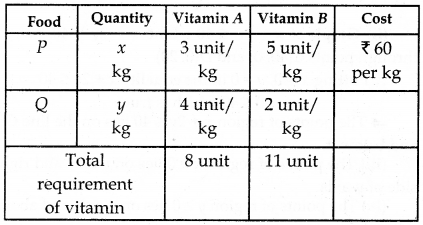
Cost of both food = 60x + 80y
∴ Objective function Z = 60x + 80y
Total quantity of vitamin A 3x + 4y which is at least 8 units.
Thus 3x + 4y ≥ 8
Total quantity of vitamin B 5x + 2y which is at least 11 units.
Thus 5x + 2y ≥ 11
So, Minimize Z = 60x + 80y
Subject to the constraints : 3x + 4y ≥ 8 5x + 2y ≥ 11 x,y ≥ 0
(i) Graph of 3x + 4y ≥ 8 : Line 3x + 4y = 8, passes through points A(\(\frac{8}{3}\), 0) and B(0, 2).
Putting x = 0, y = 0 in the inequality 3x + 4y ≥ 8
0 ≥ 8 which is not true.
⇒ The points of region 3x + 4y ≥ 8 lies on the line AB and above the line AB.
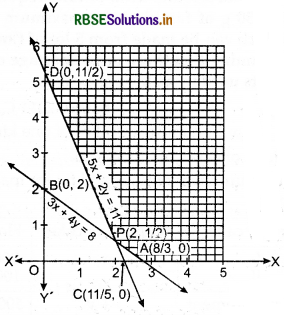
(ii) Graph of 5x + 2y ≥ 11: Line 5x + 2y = 11, passes through the points C(\(\frac{11}{5}\), 0) and D(0, \(\frac{11}{2}\))
∴ Putting x = 0, y = 0 in 5x + 2y ≥ 11 0 ≥ 11 which is not true.
⇒ The points of region 5x + 2y≥ 11 lies on the line CD and above the line CD.
(iii) The points of region x ≥ 0 lies on y-axis and right side of y-axis.
(iv) The points of region y ≥ 0 lies on x-axis and above x-axis.
∴ The feasible region of this problem is YDP AX. Intersection point of line AB : 3x + 4y = 8 and line
CD : 5x + 2y = 11 is (2, \(\frac{1}{2}\)).
Now, objective function: Z = 60x + 80y
At point D(0, \(\frac{11}{2}\)), Z = 0 + 80 × \(\frac{11}{2}\)
= 40 × 11 = 440
At point p(2, \(\frac{1}{2}\))
Z = 0 + 80 × \(\frac{1}{2}\)
= 120 + 40 = 160
At point A(\(\frac{8}{3}\), 0), Z = 60 × \(\frac{8}{3}\) + 0
= 20 × 8 = 160
Minimum value of Z is 160 but feasible region is unbounded. Now consider the inequality 60x + 80y ≤ 160 there is no any common region in 60x + 80y ≤ 160 or 3x + 4y ≤ 8 and feasible region.
Hence, minimum value of Z is ₹ 160 which is each point of AP.

Question 2.
One kind of cake requires 200 g of flour and 25 g of fat, and another kind of cake requires 100 g of flour and 50 g of fat. Find the maximum number of cakes which can be made from 5 kg of flour and 1 kg of fat assuming that there is no shortage of the other ingredients used in making the cakes.
Answer:
Let x be number of cakes of one kind and y be the number of cakes of other kind.
The requirement of flour and fat for making cake is as follows:

Total number of cakes = x + y
∴ objective function = x + y
Requirement of flour = 200x + 100y
Given flour = 5000 g
⇒ 200x + 100y ≤ 5000
or 2x + y ≤ 50
Requirement of fat = 25x + 50y
Given fat = 1000 g
∴ 25x + 50y ≤ 1000
or x + 2y ≤ 40
Subject to constraints: 2x + y ≤ 50, x + 2y ≤ 40, x, y ≥ 0
(i) Graph of 2x + y ≤ 50 : Line 2x + y = 50, passes through points A(25, 0) and B(0,50)
∴ Putting x = 0, y = 0 in inequality 2x + y ≤ 50 0 ≤ 50 which is true
⇒ The points of region 2x + y ≤ 50 lies on the line AB and below it.
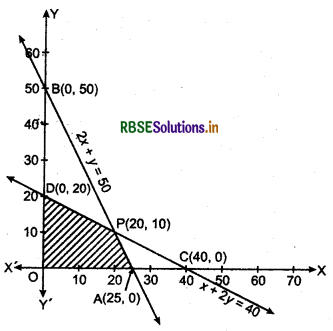
(ii) Graph of x + 2y ≤ 40 : Line x + 2y = 40, passes through points C(40, 0) and D(0, 20)
∴ Putting x = 0, y = 0 in the equality x + 2y ≤ 40 0 ≤ 40 which is true.
⇒ The points of region x + 2y ≤ 40 lies on the line CD and below it.
(iii) The points of region x ≥ 0 lies on y-axis and right side of y-axis.
(iv) The points of region y ≥ 0 lies on x-axis and above x-axis.
∴ The feasible region of this problem is OAPD.
Intersection point of line AB: 2x + y = 50 and line CD: x + 2y = 40 is P(20,10).
Now, objective function:
Z = x + y
At point A(25, 0), Z = 25 + 0 = 25
At point P(20,10), Z = 20 + 10 = 30
At point D(0, 20), Z = 0 + 20 = 20
Maximum value of Z is 30 which is at point P(20, 10).
Hence, the maximum number of cakes that can be made is 30. i.e., 20 of one kind and 10 of the other kind.
Question 3.
A factory makes tennis rackets and cricket j bats. A tennis racket takes 1.5 hours of machine time and 3 hours of craftman's time in its making while a cricket bat takes 3 hour of machine time and 1 hour of craftman's time. In a day, the factory has the availability of not more than 42 hours of machine time and 24 hours of craftsman's time.
(i) What number of rackets and bats must be made if the factory is to work at full capacity?
(ii) If the profit on a racket and on a bat is ₹ 20 and ₹ 10 respectively, find the maximum profit of the factory when it works at full capacity.
Answer:
Suppose factory makes x tennis racket and y cricket bats in a day.
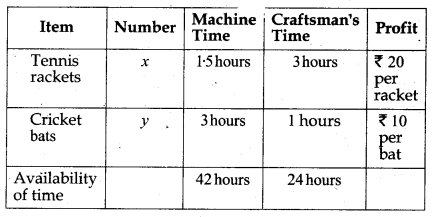
Total time of machine = 1.5x + 3y which is maximum 42 hours.
⇒ 1.5x + 3y ≤ 42
or x + 2y ≤ 28
Total time of craftsman: 3x + y, which is available for 24 hours.
∴ 3x + y ≤ 24
Thus, profit of x rackets and y bats = 20x + 10y
Now, objective function : Z = 20x + 10y and Subject to constraints :
x + 2y ≤ 28, 3x + y ≤ 24, y ≥ 0
(i) Line x + 2y = 28, passes through the points A(28,0) and B(0,14).
Putting x = 0, y = 0 in x + 2y ≤ 28
0 ≤ 28 which is true.
⇒ The points of region x + 2y ≤ 28 lies on the line AB and below it.
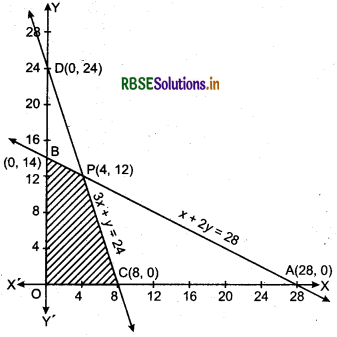
(ii) Line 3x + y = 24, passes through the points C(8, 0) and D(0,24).
Putting x = 0, y = 0 in inequality 3x + y ≤ 24 0 ≤ 24 which is true.
∴ The points of region 3x + 4y ≤ 24 lies on the line CD and below it.
(iii) Intersection point of line AB : x + 2y = 28 and line CD : 3x + y = 24 is P(4,12).
Now, objective function : Z = 20x + lOy
At point C(8,0),
Z = 20 × 8 + 0 = 160
At point P(4,12),
Z =20 × 4 + 10 × 12
= 80 + 120 = 200
At point D(0,14),
Z = 20 × 0 + 10 × 14 = 140
Hence, maximum profit is₹ 200 when 4 rackets and 12 bats be made.
(i) 4 rackets and 12 bats must be made if the factory is to work at full capacity.
(ii) Maximum profit is ₹ 200.

Question 4.
A manufacturer produces nuts and bolts.
It takes 1 hour of work on machine A and 3 hours on machine B to produce a package of nuts. It takes 3 hours on machine A and 1 hour on machine B to produce a package of bolts. He earns a profit of Rs 17.50 per package on nuts and Rs 7.00 per package on bolts. How many package of each should be produced each day so as to maximise his profit, if he operates his machines for at the most 12 hours a day ?
Answer:
Let the ,manufacture produce x nuts and y bolts.
Given:
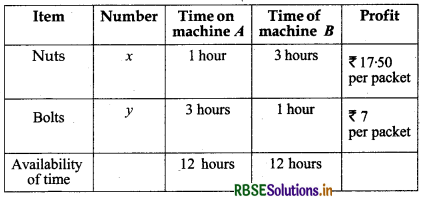
Time when machine A is used = x + 3y hours
Availiable time = 12 hours
∴ x + 3y ≤ 12
Time when machine B is used = 3x + y hours
Available time = 12 hours
∴ 3x + y ≤ 12
Total profit = 17.50x + 7.00y
Now, objecitve function:
Z = 175x + 7y
and subject to constraints:
x + 3y ≤ 12
3x+y ≤ 12
x, y ≥ 0
0 ≤ 12 which is true.
(I) Graph of x + 3y ≤ 12: Line x + = 12 passes through the point A(12, 0) and B(0, 4).
∴ Putting x = 0, y = 0 in inequality x + 3y ≤ 12
= The points of region x + 3y ≤ 12 lies on the line AB and below it.
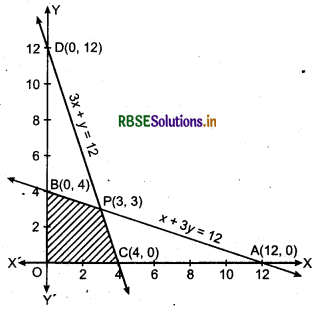
(ii) Graph of 3x + y ≤ 12: Line 3x + y = 12 passes
through points C(4, 0) and D(0, 12).
Putting x = 0, y = 0 in inequality 3x + y ≤ 12
0 ≤ 12, which is true.
= The points of region 3x + y ≤ 12 lies on the line CD and below it.
(iii) The points of region x ≥ O lies on y-axis and right side of y-axis.
(iv) The points of region y ≥ O lies on x-axis and above x-axis.
(v) Intersection point of line AB : x + 3y = 12 and line CD: 3x + y = 12 is P(3,3).
∴ The feasible region of this problem is OCPB.
Now, objective function Z = 17.5x + 7y
At point C(4, O), Z = 17.5 × 4 + 0 = 70
At point P(3, 3), Z = 17.5 × 3 + 7 × 3 = 73.5
At point B(O,4),Z = 17.5 × 0 + 7 × 428
Hence, 3 packages of nuts and 3 packages of bolts should be produced each day to get the maximum profit of 73.50.

Question 5.
A factory manufactures two types of screws, A and B. Each type of screw requires the use of two machines, an automatic and a hand operated. It takes 4 minutes on the automatic and 6 minutes onhand operated machines to manufacture a package of screws A, while it takes 6 minutes on automatic and 3 minutes on t1 hand operated machines to manufacture a package of screws B. Each machine is available for at the most 4 hours on any day. The manufacturer can sell a package of screws A at a profit of 7 and screws B at a profit of 10. Assuming that he can sell all the screws he manufactures, how many packages of each type should the factory owner produce in a day in order to maximise his profit? Determine the maximum profit.
Answer:
Let the manufacturer produces x package of screws A and y package of screws B.
Given:
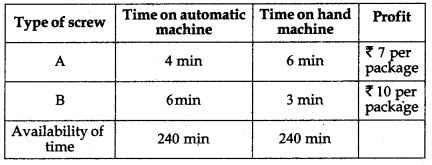
Now, Objective function Z = 7x + 10y
Subject to constraints 4x + 6y ≤ 240
x, y ≥ 0
or 2x + 3y ≤ 120
2x + y ≤ 80
x, y ≥ 0
(i) Graph of 2x + 3y ≤ 120 : Line 2x + 3y = 120 passes through points A(0,40) and E(60,0).
Putting x = 0,y = 0 in inequality 2x + 3y ≤ 120
0 ≤ 120 which is true.
⇒ The points of region 2x + 3y ≤ 120 lies on the line AB and below it.
(ii) Graph of 2x + y ≤ 80 : Line 2x + y = 80 passes through points C(40, 0) and D(80,0).
∴ Putting x = 0, y = 0 in inequality 2x + y ≤ 80 0 ≤ 80 which is true.
⇒ The points of region 2x + y ≤ 80 lies on the line CD and below it.
(iii) The points of region x ≥ 0 lies on y-axis and right side of y-axis.
(iv) The points of region y ≥ 0 lies on x-axis and above x-axis.
(v) Intersection point of line AB : 2x + 3y = 120 and line CD : 2x + y = 80 is B(30, 20).
∴ The feasible region of this problem is OABC.
Now, objective function:
Z = 7x + 10y
At point A(0, 40),
Z = 7 × 0 + 10 × 40 = 400
At point B (30, 20),
Z = 7 × 30 + 10 × 20 = 210 + 200 = 410
At point C (40,0),
Z = 7 × 40 + 0 = 280
Hence, maximum profit is ₹ 410 when 30 packages of screws of type A and 20 packages of screws of type B is manufactured.
Question 6.
A cottage industry manufactures pedestal lamps and wooden shades, each requiring the use of grinding/cutting machine and a sprayer. It takes 2 hours on grinding/cutting machine and 3 hours on the sprayer to manufacturer a pedestal lamp. It takes 1 hour on the grinding/cutting machine and 2 hours on the sprayer to manufacture a shade. On any day, the sprayer is available for at the most 20 hours and the grinding/cutting machine for at the most 12 hours. The profit from the sale of a lamp is ₹ 5 and that from a shade is ₹ 3. Assuming that the manufacturer can sell all the lamps and shades that he produces, how should he schedule his daily production in order to maximise his profit ?
Answer:
Suppose x pedestal lamps and y wooden shades is manufactured.
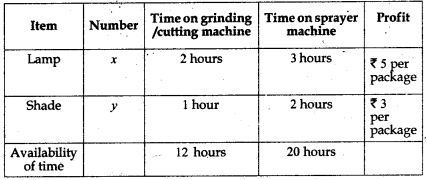
Objective function: Z = 5x + 3y and Subject to constraints 2x + y ≤ 12,3x + 2y ≤ 20
(i) Graph of 2x + y ≤ 12 : Line 2x + y = 12 passes through points A(6,0) and B(0,12)
Putting x = 0, y = 0 in inequality 2x + y ≤ 12 0 ≤ 12 which is true.
⇒ The points of region 2x + y ≤ 12 lies on the line AB and below it.
(ii) Graph of 3x + 2y ≤ 20 : Line 3x + 2y = 20 passes
through points C(\(\frac{20}{3}\), 0) and D(0, 10).
Putting x = 0, y = 0 in inequality 3x + 2y ≤ 20 0 ≤ 20 which is true.
⇒ The points of region 3x + 2y ≤ 20 lies on the line CD and below it.

(iii) The points of region x ≥ 0 lies on y-axis and right side of y-axis.
(iv) The points of region y ≥ 0 lies on x-axis and above y-axis.
(v) Intersection point of line AB : 2x + y = 12 and line CD : 3x + 2y = 120 is P(4, 4).
∴ The feasible region of this problem is OAPD.
Now objective function:
Z = 5x + 3y
At point A(6, 0) Z = 5 × 6 + 0 = 30 .
At point P(4,4) Z = 5 × 4 + 3 × 4 = 20 + 12 = 32
At point D( 0,10) Z = 5 × 0 + 3 × 10 = 30
Hence, maximum profit is ₹ 32, if manufacturer produces 4 lamps and 4 shades daily.

Question 7.
A company manufactures two types of novelty souvenirs made of plywood. Souvenirs of type A require 5 minutes each for cutting and 10 minutes each for assembling. Souvenirs of type B require 8 minutes each for cutting and 8 minutes each for assembling. There are 3 horns and 20 minutes available for cutting and 4 hours for assembling. The profit is ₹ 5 each for type A and ₹ 6 each for type B souvenirs. How many souvenirs of each type should the company manufacture in order to maximise the profit?
Answer:
Suppose x novelty souvenirs of type A and y novelty souvenirs of type B is manufactured by the company.
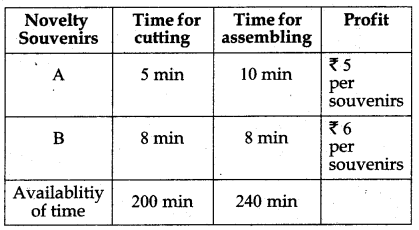
Objective function: Z = 5x + 6y and Subject to constraints 5x + 8y ≤ 200 10x + 8y ≤ 240 x, y ≥ 0
or 5x + 8y ≤ 200
5x + 4y ≤ 120
x, y ≥ 0
(i) Graph of 5x + 8y ≤ 200 : Line 5x + 8y = 200 passes through points A(40,0) and B(0,25).
Putting x = 0, y = 0 in inequality 5x + 8y ≤ 200 0 ≤ 200, which is true.
⇒ The points of region 5x + 8y ≤ 200 lies on the line AB and below it.
(iii) Graph of 5x + 4y ≤ 120 : Line 5x + 4y = 120 passes through points C(24, 0) and D(0,30).
Putting x = 0, y = 0 in inequality 5x + 4y ≤ 120 0 ≤ 120 which is true.
⇒ The points of region 5x + 4y ≤ 120 lies on the line CD and below it.
(iii) The points of region x ≥ 0 lies on y-axes and right side of y-axes.
(iv) The points of region y ≥ 0 lies on x-axis and above y axis.
(v) Intersection point of line AB : 5x+ 8y = 200 and line CD : 5x + 4y = 120 is P(8, 20).
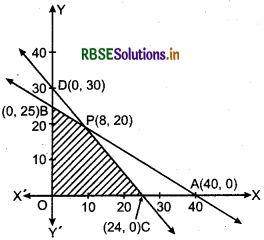
∴ The feasible region of this problem is OBPC.
Z = 5x + 6y
At point B(0, 25), Z = 0 + 6 × 25 = 150
At point P( 8,20), Z = 5 × 8 + 6 × 20 = 40 + 120 = 160
At point C(24, 0), Z = 5 × 24 + 0 = 120
Hence, maximum value is X 160 which is obtained by 8 souvenirs of type A and 20 souvenirs of type B produced each day by the company.
Question 8.
A merchant plans to sell two types of personal computers—a desktop model and a portable model that will cost ₹ 25000 and ₹ 40000 respectively. He estimates that the total monthly demand of computers will not exceed 250 units. Determine the number of units of each type of computers which the merchant should stock to get maximum profit if he does not want to invest more than ₹ 70 lakhs and if his profit on the desktop model is ₹ 4500 and on portable model is ₹ 5000.
Answer:
Let the merchant stocks x desktop computers and y portable computers.
Given:
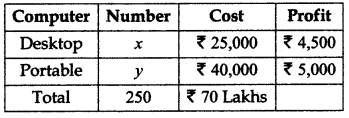
objective function: Z = 4500x + 5000y and
subject to constraints x + y ≤ 250
25000x + 40000y ≤ 70,00,000
or 5x + 8y ≤ 1400 and x, y ≥ 0
(i) Graph of x + y ≤ 250 : Line x + 2y = 250 passes through points A(250, 0) and B(0,250).
Putting x = 0, y = 0 in inequality x + y ≤ 250 0 ≤ 250 which is true.
⇒ The points of region x + y ≤ 250 lies on the line AB and below it.
(ii) Graph of 5x + 8y ≤ 1400: Line 5x + 8y = 1400 passes through points C(280,0) and D(0,175).
Putting a: = 0, y = 0 in inequality 5x + 8y ≤ 1400 0 ≤ 1400 which is true.
⇒ The points of region 5x + 8y ≤ 1400 lies on the line CD and below it.
(iii) The points of region x ≥ 0 lies on y-axis and right side of y-axis.
(iv) The points of region y ≥ 0 lies on x-axis and above x axis.
(v) Intersection point of line AB : x + y = 250 and line CD : 5x + 8y = 1400 is P(200,50).
∴ The feasible region of this problem is OAPD.
Now, objective function: Z = 4500x + 5000y At point A(25,0),
Z =4500 × 250 + 0 = 1125000
At point P(200,50),
Z = 4500 × 200 + 5000 × 50
= 900000 + 250000
= 1150000
At point D(0,175),
Z = 0 + 5000 × 175 = 875000
Hence, maximum profit of marchant is ₹ 11,50,000, whenever the merchant should stock 200 desktop and 50 portable computers.
Question 9.
A diet to contain at least 80 units of vitamin A and 100 units of minerals. Two foods F1 and F2 are available. Food F1 costs ₹ 4 per unit food arid F2 costs ₹ 6 per unit. One unit of food contains 3 units of vitamin A and 4 units of minerals. One unit of food F2 contains 6 units of vitamin A and 3 units of minerals. Formulate this as a linear programming problem. Find the minimum cost for diet that consists of mixture of these two foods and also meets the minimal nutritional requirements.
Answer:
Let the diet contains x unit of food F1 and y unit of food F2
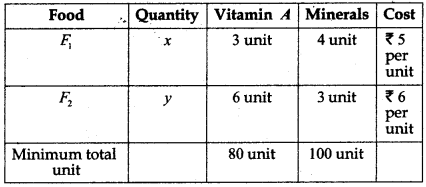
∴ Objective function:
Z = 4x + 6y a and Subject to constraints 3x + 6y ≥ 80 4x + 3y ≥ 100 x,y ≥ 0
(i) Graph of 3x + 6y ≥ 80
Line 3x + 6y = 80 passes through points A(\(\frac{80}{3}\), 0) and B(0, \(\frac{40}{3}\))
∴ Putting x = 0, y = 0 in inequality 3x + 6y ≥ 80 0 ≥ 80 which is not true.
⇒ The points of region 3x + 6y ≥ 80 lies on the line AB and above it.
(ii) Graph of ix + 3y ≥ 100: Line 4x + 3y = 100 passes through points C(25,0) and D(0, \(\frac{100}{3}\))
Putting x = 0, y = 0 in inequality 4x + 3y ≥ 100 0 ≥ 100 which is not true
⇒ The points of region 4x + 3y ≥ 100 lies on the line CD and above it.
(iii) The points of region x ≥ 0 lies on x axis and right side of y-axis.
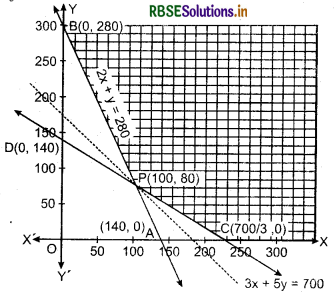
(iv) The points of region y ≥ 0 lies on x-axis and above x-axis.
(y) Intersection point o line AB : 3x + 6i = 80 and line CD: 4x + 3y = 100 is P(24, \(\frac{4}{3}\))
∴ The feasible region of this problem is YDPAX.
Now objecitve function: Z = 4x + 6y
At point D(0, \(\frac{100}{3}\))
Z = 0 + 6 × \(\frac{100}{3}\) = 200
At point P(24, \(\frac{4}{3}\))
Z = 4 × 24 + 6 × \(\frac{4}{3}\)
= 96 + 8 = 104
At point A(\(\frac{80}{3}\), 0)
Z = 4 × \(\frac{80}{3}\) + 0
= \(\frac{320}{3}\) = 106\(\frac{2}{3}\)
Hence, minimum value is ₹ 104 but feasible region

Question 10.
There are two types of fertilisers F1 and F2 consists of 10% nitrogen and 6% phosphoric acid F1 and F2 consists of 5% nitrogen and 10% phosphoric acid. After testing the soil conditions, a farmer finds that she needs atleast 14 kg of nitrogen and 14 kg of phosphoric acid for her crop. If F1 costs ₹ 6/kg and F2 costs ₹ 5/kg, determine how much of each type of fertiliser should be used so that nutrient requirements are met at a minimum cost. What is the minimum cost?
Answer:
let the farmer uses x kg of F1 and y kg of F2 fertilizers.
Given:

Objective function : Z = 6x + 5y and Subject to constraints:
\(\frac{10}{100}\)x + \(\frac{5}{100}\)y ≥ 14
\(\frac{6}{100}\)x + \(\frac{10}{100}\)y ≥ 14
or 2x + y ≥ 280
3x + 5y ≥ 700
x, y ≥ 0
(i) Graph of 2x + y ≥ 280 : Line 2x + y = 28o passes through points A(140, 0) and B(O, 220).
Putting x = 0, y = 0 in inequality 2x + y ≥ 280
0 ≥ 280 which is not true.
The points of region 2x + y ≥ 280 lies on the line AB and above it.
(ii) Graph of 3x + 5y ≥ 700: Line 3x + 5y ≥ 700 passes through points C(\(\frac{700}{3}\), o) and D(0, 140).
Putting x = 0, y = 0 in inequality 3x + 5y ≥ 700
700 which is not true.
⇒ The points of region 3x + 5y ≥ 700 lies on the line CD and above it.
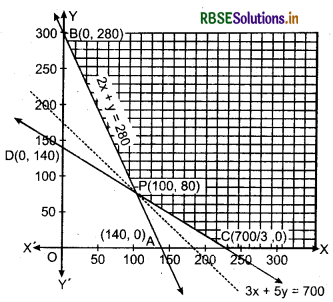
(iii) The points of region x ≥ 0 lies on y-xis and right side of y-axis.
(iv) The points of region y ≥ 0 lies on x-axis and above x-axis.
(y) Intersection point of line AB : 2x + y = 280 and line CD : 3x + y = 700 is P(100, 80).
∴ The feasible region of this problem is YBPCX.
Now objective function:
Z = 6x + 5y
At point B(0, 280),
Z = 0 + 5 × 280 = 1400
At point P(100, 80),
Z = 6 × 100 + 5 × 80
= 600 + 400 = 1000
At point C(\(\frac{700}{3}\), 0)
Z = 6 × \(\frac{700}{3}\) + 0
= 2 × 700 = 1400
Hence, minimum value is ₹ 1000 but feasible region is unbounded. Any point of region 6x + 5y ≤ 1000 and feasible region is not common.
In this way 100 kg of fertiliser F1 and 80 kg of fertiliser F2 should be used to minimize the cost. The minimum cost is ₹ 1000.
Question 11.
The corner points of the feasible region determinedbythefollowingsystem of linear inequalities: 2x + y ≤ 10, x + 3y ≤ 15, x, y ≥ 0 are (0,0), (5,0), (3,4) and (0,5).
Let Z = px + qy, where p,q ≥ 0. Condition on p and q so that the maximum of Z occurs at both (3,4) and (0,5) is (A)p = q (B)p = 2q (C)p = 3q (D)q = 3p
Answer:
Here, objective function ;
Z = px + qy
At point (3,4)
Z = 3p + 4q
At point (0,5)
Z = 0 + 5q
Here, both the values are maximum and equal.
∴ 3p + 4 = q
3p = q
3p=q
Here, option (D) is correct.

- RBSE Class 12 Maths Notes Chapter 13 Probability
- RBSE Class 12 Maths Notes Chapter 12 Linear Programming
- RBSE Class 12 Maths Notes Chapter 11 Three Dimensional Geometry
- RBSE Class 12 Maths Notes Chapter 10 Vector Algebra
- RBSE Class 12 Maths Notes Chapter 9 Differential Equations
- RBSE Class 12 Maths Notes Chapter 8 Application of Integrals
- RBSE Class 12 Maths Notes Chapter 7 Integrals
- RBSE Class 12 Maths Notes Chapter 6 Application of Derivatives
- RBSE Class 12 Maths Notes Chapter 5 Continuity and Differentiability
- RBSE Class 12 Maths Notes Chapter 4 Determinants
- RBSE Class 12 Maths Notes Chapter 3 Matrices